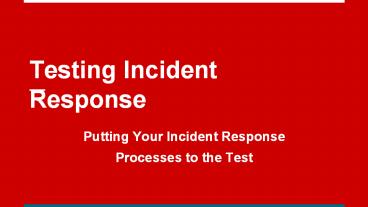Incident Response Testing - PowerPoint PPT Presentation
Title:
Incident Response Testing
Description:
As the cybersecurity landscape continues to evolve and threat actor sophistication increases, it is ever more important that you not only have incident response processes in place but that you ensure they work consistently. And, of course, you should continuously iterate and improve over time. Visit - – PowerPoint PPT presentation
Number of Views:129
Title: Incident Response Testing
1
Testing Incident Response
- Putting Your Incident Response
- Processes to the Test
2
Introduction
- Your class being gathered and ushered into the
centermost room of your school. - Schools run tornado and fire drills so everyone
knows what to do, when. Plus, you dont want to
find out your emergency plans dont work at the
moment disaster actually strikes. - So why arent we applying this logic more
broadly in cybersecurity?
3
Are You Regularly Testing Your Incident Response
Processes?
4
Incident Response in Kindergarten
- Security operations leaders would do well to take
a queue from the emergency drills of their
childhood when it comes to their incident
response programs and processes. What makes sense
on paper or the whiteboard often doesnt work as
planned when put into practice.
5
Cybersecurity Incident Response
- As the cybersecurity landscape continues to
evolve and threat actor sophistication increases,
it is ever more important that you not only have
incident response processes in place but that you
ensure they work consistently. And, of course,
you should continuously iterate and improve over
time.
6
IR Processes and the School of Hard Knocks
- While many organizations go a great lengths to
set up effective security operations incident
response plans, very few proactively test their
processes to ascertain how they will work when
faced with a real threat. SANS found that only
33 of organizations periodically review and
update their incident response processes, while
another 25 only review and update their
processes after a major incident.
7
Assessment of IR Process
8
How to Test Your IR Processes
- Paper tests are mostly theoretical and may be a
first step for security operations teams who
dont have well-documented incident response
processes. - Tabletop exercises are just that - stakeholders
around a table running through a security event
scenario. This technique allows teams to review
and practice the various actions detailed in an
incident response process. - Simulated Attacks - A fully simulated attack is
the most effective way of pressure testing your
incident response processes as it uses real life,
controlled attacks to see how an organization
will respond when hit by an external threat. For
instance, an organization can simulate the
deployment of a known threat
9
Simulated Attacks
10
Optimizing Your IR Processes
- Testing your incident response processes yield
two important results - a clear understanding of
whether your plan is likely to work and a list of
gaps that should be addressed. - Your incident response playbooks should always be
updated after theyve been put to use, whether in
a simulated scenario or as part of real security
incident triage and remediation. And, through
testing, you should identify opportunities to
apply automation to your incident response
processes to expedite remediation and keep your
analysts focused on the highest value tasks.
11
The Role of Playbooks
- Everything weve discussed in this article
assumes your organization has some level of
documentation for your incident response
processes. - Playbooks ensure that everyone in your
organization is on the same page, will execute
processes the same way and knows what their role
is in the event of an incident. As with attack
simulations, there are a variety of ways to
approach playbook creation, including automated
playbooks available within many security
orchestration platforms.
12
Conclusion
- Having the best incident response plan is only as
good the paper its written on if it fails to
provide a suitable response to a threat. Your
incident response processes should be codified,
documented and regularly pressure tested for
vulnerabilities. And you must ensure that
playbooks exist and are regularly updated to
reflect lessons learned from the tests and actual
incidents.































